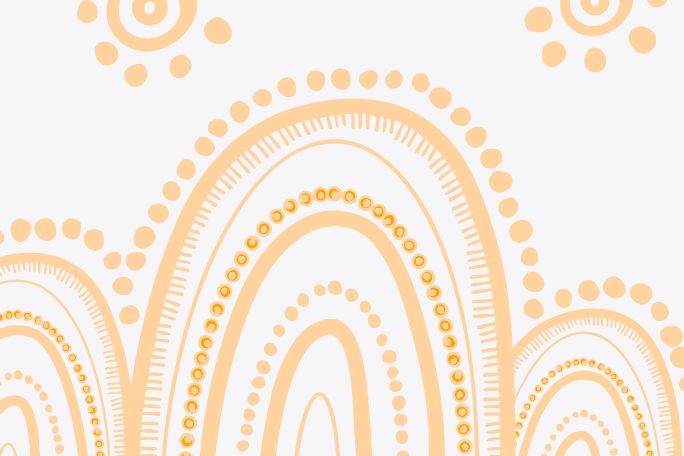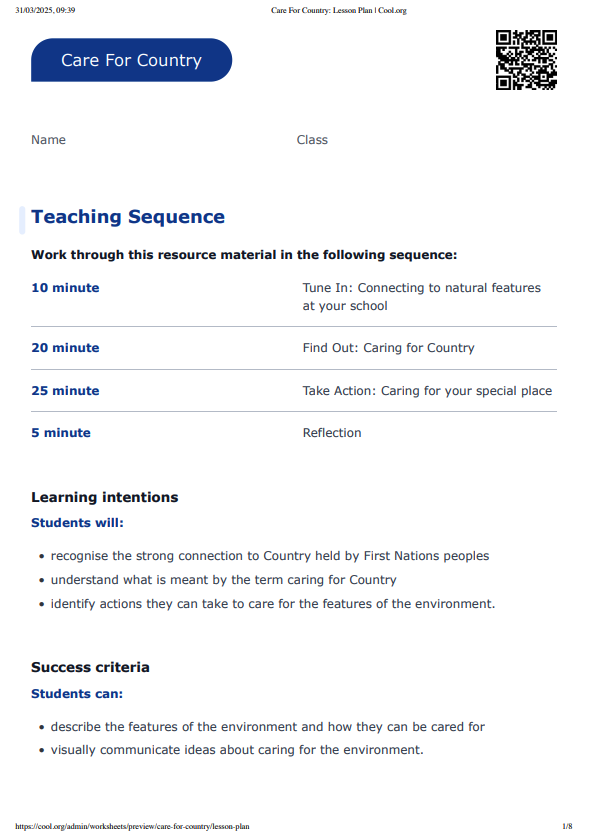Lesson summary
Students will explore what ‘caring for Country’ means. They will discuss Aboriginal and Torres Strait Islander peoples connection to Country and will recognise features of the environment at their school and the actions that can be taken to care for them.
Learning intentions
Students will;
- recognise the strong connection to Country held by First Nations peoples
- understand what is meant by the term caring for Country
- identify actions they can take to care for the features of the environment.
Success criteria
Students can;
- describe the features of the environment and how they can be cared for
- visually communicate ideas about caring for the environment.
Lesson guides and printables
Curriculum links
Select your curriculum from the options below.
Lesson details
Skills
This lesson is designed to build students’ competencies in the following skills:
- communication
- creative thinking
- critical thinking
- intercultural understanding
Curriculum Mapping
Australian Curriculum (v9.0) content description:
F-2, Geography
Students learn:
- the importance of Country/Place to First Nations Australians and the Country/Place on which the school is located (AC9HSFK04)
- how places change and how they can be cared for by different groups including First Nations Australians (AC9HS1K04)
- about the interconnections of First Nations Australians to a local Country/Place (AC9HS2K04).
Relevant parts of Foundation Year achievement standards: Students recognise the features of familiar places, why some places are special to people and the ways they can care for them.
Relevant parts of Year 1 achievement standards: Students identify the location and nature of the natural, managed and constructed features of local places, the ways places change, and how they can be cared for by people.
Relevant parts of Year 2 achievement standards: Students identify how people and places are interconnected both at local and broader scales.
General capabilities: Intercultural Understanding
Cross-curriculum priority: Aboriginal and Torres Strait Islander Histories and Cultures, Sustainability
Level of teacher scaffolding: Medium - oversee class discussions and lead students in the brainstorming task and the independent poster/artwork activity.
UN Sustainable Development Goals
Target 15.5: Take urgent and significant action to reduce the degradation of natural habitats, halt the loss of biodiversity and, by 2020, protect and prevent the extinction of threatened species
Resources Required
- A range of photos of features and places in your local area, such as the shops, park, beach, your school - ensure you have at least one image of a natural feature at your school (e.g. the big tree at the back of the oval, or a garden, or a grassy area)
- Poster-making materials.
Additional Info
This is an original Cool+ lesson.
Related Professional Learning
Beginning to Include First Nations Peoples' Perspectives in Your Classroom (45 Minutes)
Quick summary: This course aims to inform and upskill educators in incorporating Aboriginal and Torres Strait Islander peoples perspectives. The course emphasises the importance of connecting with personal motivations, overcoming biases, and incorporating diverse perspectives while being inclusive of Aboriginal and Torres Strait Islander peoples languages and cultures. Additionally, it provides guidance on terms of reference, protocols, and strategies for inclusivity, fostering an inclusive and accepting educational environment and curriculum design.


Welcome back!
Don't have an account yet?
Log in with:
Create your free Cool.org account.
Many of our resources are free, with an option to upgrade to Cool+ for premium content.
Already have an account?
Sign up with:
By signing up you accept Cool.org's Terms and Conditions(Opens in new tab) and Privacy Policy(Opens in new tab).